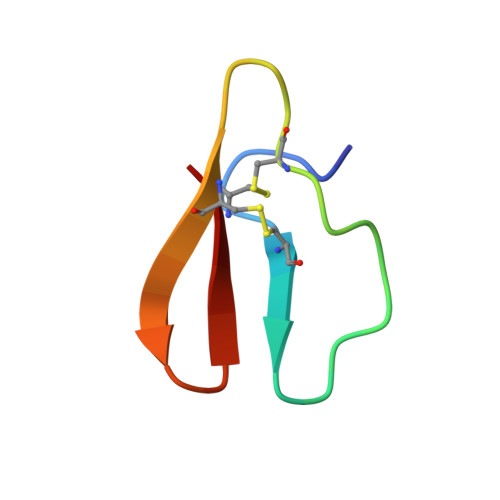O-glycosylation effects on family 1 carbohydrate-binding module solution structures.
Happs, R.M., Guan, X., Resch, M.G., Davis, M.F., Beckham, G.T., Tan, Z., Crowley, M.F.(2015) FEBS J 282: 4341-4356
- PubMed: 26307003
- DOI: https://doi.org/10.1111/febs.13500
- Primary Citation of Related Structures:
2MWJ, 2MWK - PubMed Abstract:
Family 1 carbohydrate-binding modules (CBMs) are ubiquitous components of multimodular fungal enzymes that degrade plant cell wall polysaccharides and bind specifically to cellulose. Native glycosylation of family 1 CBMs has been shown to substantially impact multiple physical properties, including thermal and proteolytic stability and cellulose binding affinity. To gain molecular insights into the changes in CBM properties upon glycosylation, solution structures of two glycoforms of a Trichoderma reesei family 1 CBM were studied by NMR spectroscopy: a glycosylated family 1 CBM with a mannose group attached to both Thr1 and Ser3 and a second family 1 CBM with single mannose groups attached to Thr1, Ser3 and Ser14. The structures clearly reveal that monosaccharides at both Ser3 and Ser14 on family 1 CBMs present additional cellulose binding platforms, similar to well-characterized aromatic residues at the binding interface, which align to the cellulose surface. These results are in agreement with previous experimental work demonstrating that glycans at Ser3 and Ser14 impart significant improvements in binding affinity. Additionally, detailed analysis of the NMR structures and molecular simulations indicates that the protein backbone of the CBM is not significantly altered by attachment of monosaccharides, and that the mannose attached to Ser14 may be more flexible than the mannose at Ser3. Overall, the present study reveals how family 1 CBM structures are affected by covalent attachment of monosaccharides, which are likely important post-translational modifications of these common subdomains of fungal plant cell wall degrading enzymes. Structural data have been deposited in the RCSB Protein Data Bank (PDB codes: 2MWJ and 2MWK) and the BioMagRes Bank (BMRB codes: 25331 and 25332) for CBM_M2 and CBM_M3, respectively.
- National Renewable Energy Laboratory, National Bioenergy Center, Golden, CO, USA.
Organizational Affiliation:

















